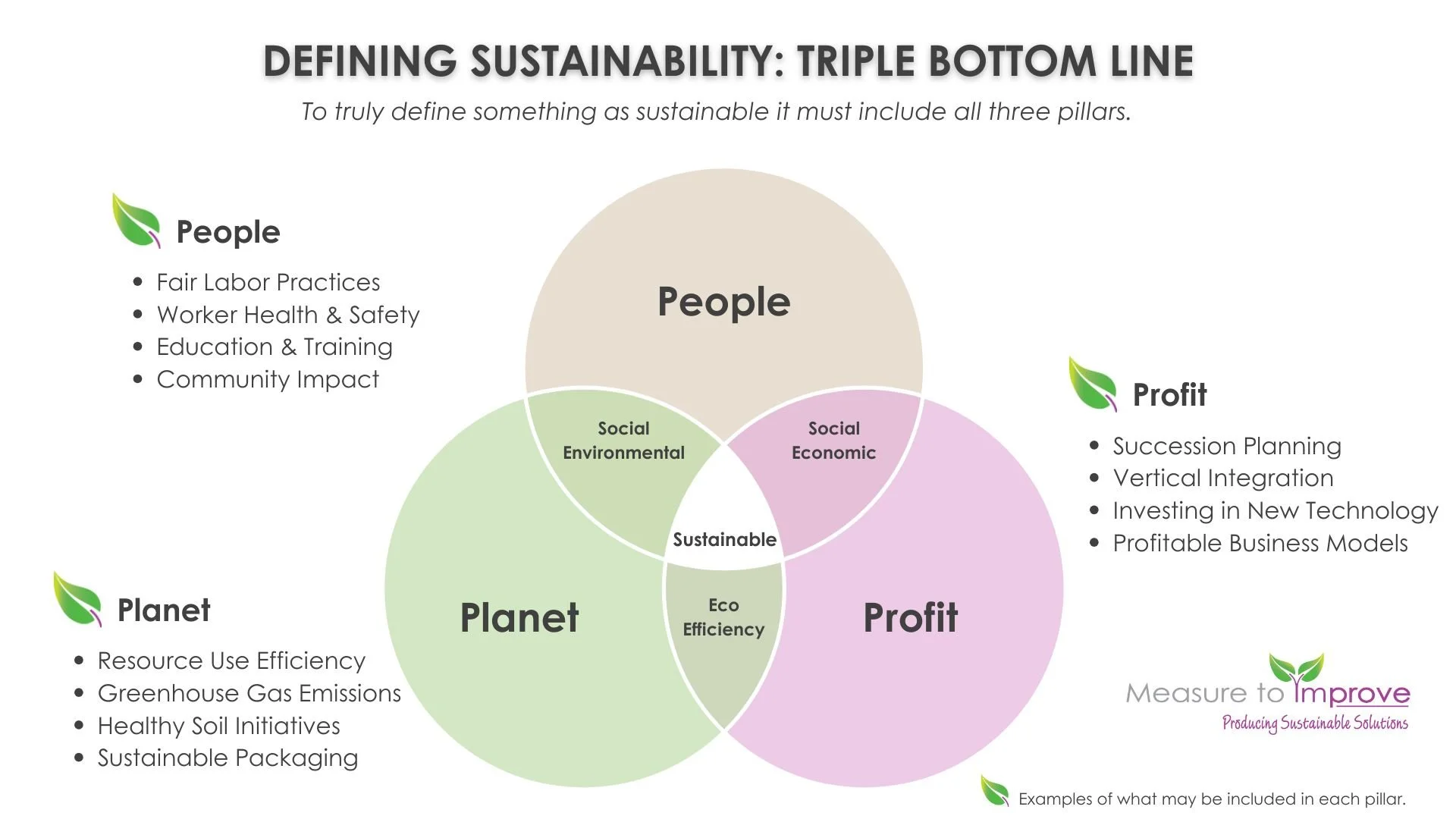The 3 P’s of Sustainability: A Guide for the Fresh Produce Industry
Sustainability isn’t just a trend in fresh produce - It’s a smart, practical, and measurable approach to doing business. For produce growers, packers, and shippers, understanding sustainability through the lens of the 3 P’s—People, Planet, and Profit—offers a framework to not only understand sustainability but to guide decisions and strengthen operations.
What Are the 3 P’s of Sustainability?
The 3 P’s—People, Planet, and Profit—represent the three pillars of sustainability, also known as the triple bottom line. This framework encourages businesses to consider their impact not only economically, but also socially and environmentally.
People refers to the social aspects of sustainability: fair labor, worker well-being, and community engagement.
Planet focuses on environmental stewardship: reducing emissions, conserving resources, and protecting ecosystems.
Profit represents the economic side: building financially viable, future-ready businesses that can support continued investment in people and the planet.
To be considered truly sustainable, a business must integrate all three, ensuring that no one pillar is prioritized at the expense of the others.
People: Supporting the Workforce and the Community
Sustainability starts with people. For growers and packers, this means prioritizing the well-being of farmworkers, packing crews, and the communities where you operate. It also includes creating a workplace culture rooted in safety, equity, and opportunity.
Common examples in the fresh produce industry include:
Fair labor practices and wage standards
Worker health and safety protocols
Education and training for seasonal and full-time staff
Positive impact on surrounding communities
If you’re investing in your workforce, supporting career growth, or partnering with community initiatives, you’re already contributing to this essential part of sustainability.
Planet: Protecting Natural Resources for Future Generations
Environmental sustainability is often the most visible of the three pillars. For fresh produce growers and packers, this includes practices that conserve resources, minimize environmental harm, and protect long-term soil and ecosystem health.
Key actions may include:
Improving water, fertilizer, and energy use efficiency
Reducing greenhouse gas emissions from farm to distribution
Implementing healthy soil and regenerative agriculture initiatives
Choosing sustainable or recyclable packaging materials
These efforts not only benefit the environment, they often lead to cost savings and improved operational performance as well.
Profit: Building a Business That Last
Sustainability doesn’t mean sacrificing profitability. In fact, it can do the opposite. Many sustainability practices drive operational efficiency, reduce waste, and uncover cost-saving opportunities that directly improve the bottom line.
Profit-oriented sustainability in fresh produce might include:
Investing in new technologies that improve yield or efficiency
Developing resilient business models that withstand market fluctuations
Pursuing vertical integration to increase control and value
Creating a succession plan to ensure business continuity
Sustainability also helps companies meet increasing requirements from buyers and retailers, reduce risk, and build long-term resilience. In today’s climate, profitability and sustainability are no longer competing priorities—they’re increasingly one and the same.
Why All Three Matter
While it’s tempting to focus on one area—like improving soil health or improving worker welfare—true sustainability happens when all three pillars intersect. The most resilient operations are those that integrate People, Planet, and Profit into everyday decision-making.
For example, switching to more sustainable packaging may reduce landfill waste (Planet), improve brand perception and customer loyalty (Profit), and eliminate harmful materials or reduce physical strain for workers in the supply chain (People). When you evaluate changes through the lens of the triple bottom line, it becomes easier to recognize the full value of sustainable action.
You’re Likely Already Doing It
Many growers, packers, and shippers are surprised to discover they’ve already taken meaningful steps toward sustainability. Whether it's improving irrigation systems, training new employees, or investing in post-harvest technology, these practices reflect a commitment to doing business responsibly. The opportunity is to build on those wins with intention and structure.
By recognizing and building on what’s already working, you can take a more intentional approach to sustainability—one that benefits your business, your community, and the planet.
Want to strengthen your sustainability strategy?
Measure to Improve helps fresh produce companies assess where they are today and build practical, measurable plans for the future.
Let’s talk about how to turn your efforts into a clear sustainability roadmap that delivers value for your business, your community, and the planet.




